
Q. What is your impression of KAGUYA's observation results?
I have been very impressed with the quality, both of the instruments and of the results that have been returned. KAGUYA is major step in scientific exploration, with highly capable instruments.
Q. What is your impression of the initial science results from KAGUYA?
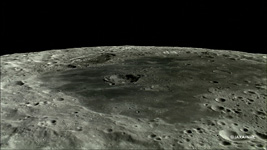
KAGUYA has determined the age of Mare Moscoviense (image by KAGUYA's high-definition camera)
I've seen a few of the papers that have already been published. The first were the results from the Terrain Camera, which were impressive. In particular the images of inside Shackleton crater were thrilling, and in many ways unexpected, because no instrument had ever seen inside these craters. The craters are of great interest to lunar scientists because the polar areas of the moon have been shown by the Lunar Prospector probe to contain excess hydrogen. And the theory was that excess hydrogen might be due to deposits of water or ice in these very cold regions. With the Terrain Camera, scientists were able to look inside these areas, which are permanently dark. And you can see quite clearly that there are no ice fields or snow banks - all you see is the interior of a crater. So what I found most interesting was not so much that the interior of the crater looked like the interior of a crater, but what you do not see. We know there's hydrogen there, but you do not see any obvious indication of water frost or water ice. What that says is that the hydrogen that's there is not in the form of ice on the surface, clean ice. The hydrogen may be buried. These instruments cannot tell what is below the surface, but these images eliminated one possibility, by showing clearly that there's no clean ice on the surface. And that was very interesting. So whether there is water in these very cold regions is still unknown. But with these remarkable images from the Terrain Camera, we have eliminated one of the possibilities.
The second initial result in science from the Terrain Camera addressed the age of the basaltic volcanism on the surface of the moon. It was very clear from the results that there is one age group of basaltic terrains [on the far side] that is similar to the age group that we see on the near side. But there's also a younger group, which was created 2.5 billion years ago. That was unexpected. So it was very valuable to have that nice, clean result come from these new data. It's very exciting to see not just these first results, but also the integration of the many different instruments that are beginning to address some scientific problems.
The second initial result in science from the Terrain Camera addressed the age of the basaltic volcanism on the surface of the moon. It was very clear from the results that there is one age group of basaltic terrains [on the far side] that is similar to the age group that we see on the near side. But there's also a younger group, which was created 2.5 billion years ago. That was unexpected. So it was very valuable to have that nice, clean result come from these new data. It's very exciting to see not just these first results, but also the integration of the many different instruments that are beginning to address some scientific problems.
Q. Among KAGUYA's achievements thus far, what has most captured your interest?
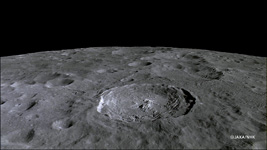
Jackson Crater, imaged by KAGUYA's high-definition camera
I find them all very interesting, because they address different aspects of lunar science. The volcanic history, the question of volatiles at the poles, the basic mineralogy of the lunar crust - these are all very important. I can't say one is more important than the other. But I'm a spectroscopist. My main research topics are analyses of lunar formation by spectroscopy. (Spectroscopy is a technique for studying matter and its properties by investigating its emission and absorption spectrum using a spectrometer.)
I've seen results from KAGUYA's spectroscopy instrument, and this was thrilling - to see new spectra for areas on the surface that had not been examined with that kind of spectral resolution before. Let's see if I can say this without getting too technical. The minerals on the surface of the moon can be identified based on diagnostic properties seen in their spectra. One extremely important mineral for understanding the formation, evolution and early history of the lunar crust is called plagioclase. In the samples of plagioclase returned from lunar areas by Apollo, trace iron was found resulting in an absorption band at a wavelength rage of approximately 1.2-1.3 micrometers. Subsequently, areas that were believed to be rich in plagioclase were studied by remote sensing, but minerals with a similar absorption band were not detected. This had been a mystery of the formation of the moon, until the Spectral Profiler and Multi-band Imager on KAGUYA provided a key to the solution. It discovered plagioclase with a similar absorption band to that of Apollo's samples in the central peak in Jackson crater on the lunar far side. That central peak is thought to have formed due to upheaval of materials from underneath the lunar surface after the moon was hit by an asteroid. So studying that peak helps us estimate the subsurface structure of the moon. It is really a wonderful discovery to help resolve the mysteries of the moon's birth and evolution.
I've seen results from KAGUYA's spectroscopy instrument, and this was thrilling - to see new spectra for areas on the surface that had not been examined with that kind of spectral resolution before. Let's see if I can say this without getting too technical. The minerals on the surface of the moon can be identified based on diagnostic properties seen in their spectra. One extremely important mineral for understanding the formation, evolution and early history of the lunar crust is called plagioclase. In the samples of plagioclase returned from lunar areas by Apollo, trace iron was found resulting in an absorption band at a wavelength rage of approximately 1.2-1.3 micrometers. Subsequently, areas that were believed to be rich in plagioclase were studied by remote sensing, but minerals with a similar absorption band were not detected. This had been a mystery of the formation of the moon, until the Spectral Profiler and Multi-band Imager on KAGUYA provided a key to the solution. It discovered plagioclase with a similar absorption band to that of Apollo's samples in the central peak in Jackson crater on the lunar far side. That central peak is thought to have formed due to upheaval of materials from underneath the lunar surface after the moon was hit by an asteroid. So studying that peak helps us estimate the subsurface structure of the moon. It is really a wonderful discovery to help resolve the mysteries of the moon's birth and evolution.
Q. Tell us about the research you are doing with data from KAGUYA?
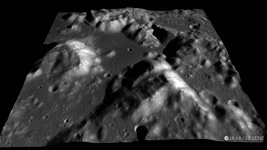
Taurus-Littrow Valley imaged by KAGUYA's terrain camera. KAGUYA has successfully observed various topographic features of the Moon.
I'm a lunar scientist. So I am very interested in understanding the history of the different terrains on the moon, the evolution of the lunar crust, the history of the basaltic terrains, etc. I have studied the distribution and composition of lunar minerals in order to better understand the formation and evolution of the lunar crust, and the characteristics and diversity of basalt in the lunar mare. I would like to further my research with data from KAGUYA.
I expect it will take us several years to integrate these data, but eventually they will become a strong foundation for all lunar scientists to understand the evolution of the moon in more detail. It's hard to predict exactly which components will be the most important, but the taste that we've received from KAGUYA has been remarkable. It's very exciting for the lunar science community, because we know this new era of exploration has really begun.
I expect it will take us several years to integrate these data, but eventually they will become a strong foundation for all lunar scientists to understand the evolution of the moon in more detail. It's hard to predict exactly which components will be the most important, but the taste that we've received from KAGUYA has been remarkable. It's very exciting for the lunar science community, because we know this new era of exploration has really begun.
Q. You are involved in India's lunar exploration mission, the Chandrayaan-1. Please tell us about its current status and the published results from the Moon Mineralogy Mapper, which you are in charge of.
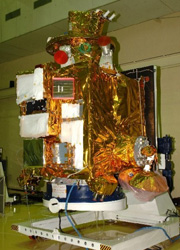
India's lunar explorer, Chandrayaan-1 (courtesy: ISRO)
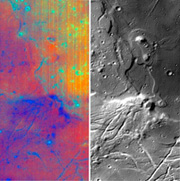
Observation data acquired by MP3 on Chandrayaan-1. A study of the mineral distribution of the Mare Orientale using different wavelengths revealed iron-bearing minerals (appearing in green). (courtesy: NASA/JPL/Brown)
The Chandrayaan-1 was launched last October, and has started its observations only recently. It is equipped with 11 scientific instruments, including the ones provided by NASA and the European Space Agency. The mission is scheduled to run two years, and I expect that it will soon start acquiring a lot of interesting data.
The Moon Mineralogy Mapper is designed to map lunar mineralogy. We have acquired interesting data from its initial observations: we detected iron-bearing minerals in Mare Orientale on the lunar far side. I am very pleased that our instrument is working very well, and I am excited about its future observations.
Q. How are the observation data from Chandrayaan-1 and KAGUYA going to complement each other?
I believe they are an excellent complementary group of instruments. Previous instruments - both Earth-based and on the Clementine and Prospector probes - were very limited in their capabilities. But now we are at a different level of capability - a much more advanced, sophisticated level of remote measurements. Each of the instruments is a little different from the others. That allows complementary measurements, but there's enough similarity that we can work on cross-calibration. We are forming a cross-calibration subgroup so that we can work together to make sure we can utilize the data from these instruments to maximize the science return, because you get slightly different resolution, slightly different field of view, slightly different range of measurements from each one.
Q. What are your hopes for future lunar exploration?
I am very excited about this new era of exploration that we are entering. The technical capability of the sensors, and the advancement with the young scientists that are becoming involved in the field are opening a new era of exploration. Now, why is that important? Well, there are several ways to answer that question.
At one level, as a scientist, I believe it's very important to understand how planets work. And you need to be able to compare different planetary bodies - the Earth, the moon, Mars, Venus - because each tells us a different story of how the basic evolution of a planet proceeds. So, that's one part. And these new data about the moon are a very important element in that because the moon, as a geologic body, is unique. Studying it is in many ways pure geology - the rocks and minerals are untouched by weather, untouched by water and rain - and so we can study them and their evolution in that regard. So, on the one hand the science of the moon is very important to understand our position in the solar system and the relationship between the Earth and the moon.
Also, the establishment of long-term exploration technology will lead to the enhancement of science and technology for all humans. Lunar exploration is a long-term project. It probably has a hundred-year horizon. And we don't know what resources are going to be most useful. We don't know what application will be there a hundred years from now, but it will happen on that kind of time frame. And it's very encouraging to see that the international community is involved, that it's not just one country. I think the moon is one of the best examples of how different nations can work in a cooperative and peaceful manner on a highly technical activity.
The Moon Mineralogy Mapper is designed to map lunar mineralogy. We have acquired interesting data from its initial observations: we detected iron-bearing minerals in Mare Orientale on the lunar far side. I am very pleased that our instrument is working very well, and I am excited about its future observations.
Q. How are the observation data from Chandrayaan-1 and KAGUYA going to complement each other?
I believe they are an excellent complementary group of instruments. Previous instruments - both Earth-based and on the Clementine and Prospector probes - were very limited in their capabilities. But now we are at a different level of capability - a much more advanced, sophisticated level of remote measurements. Each of the instruments is a little different from the others. That allows complementary measurements, but there's enough similarity that we can work on cross-calibration. We are forming a cross-calibration subgroup so that we can work together to make sure we can utilize the data from these instruments to maximize the science return, because you get slightly different resolution, slightly different field of view, slightly different range of measurements from each one.
Q. What are your hopes for future lunar exploration?
I am very excited about this new era of exploration that we are entering. The technical capability of the sensors, and the advancement with the young scientists that are becoming involved in the field are opening a new era of exploration. Now, why is that important? Well, there are several ways to answer that question.
At one level, as a scientist, I believe it's very important to understand how planets work. And you need to be able to compare different planetary bodies - the Earth, the moon, Mars, Venus - because each tells us a different story of how the basic evolution of a planet proceeds. So, that's one part. And these new data about the moon are a very important element in that because the moon, as a geologic body, is unique. Studying it is in many ways pure geology - the rocks and minerals are untouched by weather, untouched by water and rain - and so we can study them and their evolution in that regard. So, on the one hand the science of the moon is very important to understand our position in the solar system and the relationship between the Earth and the moon.
Also, the establishment of long-term exploration technology will lead to the enhancement of science and technology for all humans. Lunar exploration is a long-term project. It probably has a hundred-year horizon. And we don't know what resources are going to be most useful. We don't know what application will be there a hundred years from now, but it will happen on that kind of time frame. And it's very encouraging to see that the international community is involved, that it's not just one country. I think the moon is one of the best examples of how different nations can work in a cooperative and peaceful manner on a highly technical activity.
Carle Pieters
Professor, Department of Geological Sciences, Brown University
Dr. Pieters is a planetary geologist with a Ph.D. in Planetary Science from the Massachusetts Institute of Technology. Her research includes planetary exploration and the evolution of planetary surfaces, with an emphasis on remote compositional analyses such as spectroscopy. Dr. Pieters has been a faculty member at Brown since 1980, after having worked for several years at the Johnson Space Center in Houston and as a Peace Corps volunteer in Sarawak, Malaysia. Dr. Pieters is the Principal Investigator for NASA's Moon Mineralogy Mapper (M3) experiment, launched to the Moon in 2008, and also Co-Investigator on Dawn, a mission to explore the asteroids Vesta and Ceres. She is the Science Manager at the NASA/Keck Reflectance Experiment Laboratory (RELAB).
Professor, Department of Geological Sciences, Brown University
Dr. Pieters is a planetary geologist with a Ph.D. in Planetary Science from the Massachusetts Institute of Technology. Her research includes planetary exploration and the evolution of planetary surfaces, with an emphasis on remote compositional analyses such as spectroscopy. Dr. Pieters has been a faculty member at Brown since 1980, after having worked for several years at the Johnson Space Center in Houston and as a Peace Corps volunteer in Sarawak, Malaysia. Dr. Pieters is the Principal Investigator for NASA's Moon Mineralogy Mapper (M3) experiment, launched to the Moon in 2008, and also Co-Investigator on Dawn, a mission to explore the asteroids Vesta and Ceres. She is the Science Manager at the NASA/Keck Reflectance Experiment Laboratory (RELAB).